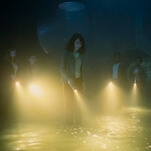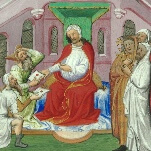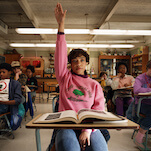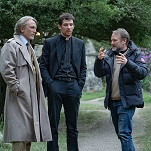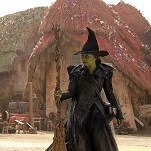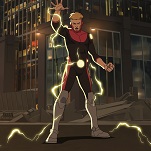Comics Panel Dissent – The Flash: Rebirth

When we were dividing up the assignments for the most recent Comics Panel, Keith and I had a brief, friendly debate over which of us should handle the first issue of The Flash: Rebirth. Keith basically enjoyed Geoff Johns and Ethan Van Sciver’s take on the Silver Age Scarlet Speedster. I read the issue and was reminded why I rarely read super-hero comics anymore.
I gave up buying individual issues of my D.C./Marvel/Wildstorm favorites about five or six years ago, in order to “wait for the trade.” And when I realized the trades were stacking up unread next to my bed, I stopped buying those too. There have been a few exceptions: I pick Astro City when I can find it; I’ve read just about all of All Star Superman; and I liked Jeff Smith’s Shazam comics. Mainly though, aside from the vintage material in the Showcase collections, just about the only time I read a super-hero comic these days is when D.C. sends one along for review purposes. And that’s only maybe a half-dozen times a year.
Still, I had mildly high hopes for The Flash: Rebirth, because whether it’s Jay Garrick, Barry Allen, Bart Allen or Wally West, I dig a speedster. Also, I'd enjoyed Geoff Johns’ first couple of years writing The Flash, years ago. But my heart sank during the opening seven pages of The Flash: Rebirth. Between the images of two police scientists getting their throats slashed (after casually chatting about framing a suspect with a history of sexual deviancy) and the way Johns and Van Sciver spend nearly a third of the issue’s page count on what’s essentially mood-setting, I felt like I was reading a handbook on how to create a dreary modern super-hero comic.
I understand that the battle over what’s appropriate content for a story featuring an iconic super-hero has long-since been lost. Any lingering notion that the D.C. universe is family-friendly went out the window when Dr. Light raped Sue Dibny. These days, as near as I can tell, darkness is the rule, not the exception. And while I prefer a little more Silver Age shine on my D.C. heroes, I’m not inherently opposed to the idea of telling more mature stories using familiar characters. (I liked that Dark Knight movie a whole bunch, for example.)
It’s just that so much about this approach to super-hero storytelling feels cliché now. The Flash: Rebirth is intended to re-establish the long-dead Barry Allen in the D.C. universe, and for the first issue Johns spends most of his time dwelling on other characters’ reactions to Barry’s return, in lengthy, action-free, plot-free conversations. Then, out of nowhere, Johns adds a new wrinkle to Barry Allen’s backstory, indicating that his mother was murdered when he was a kid, and that his father may have been responsible.
Even if Rebirth revises that flashback before it ends—revealing that the father’s innocent, for example—how does this in any way make The Flash a more interesting character? Here’s all The Flash has to do: run very fast, fight a gallery of colorful rogues in creative ways, and be a righteous dude. Barry Allen can be a little prickly about his rigid code of right and wrong, but he doesn’t need to be angst-ridden. And for the love of Savitar, the D.C. Universe doesn’t need to make its mythology any more convoluted.


